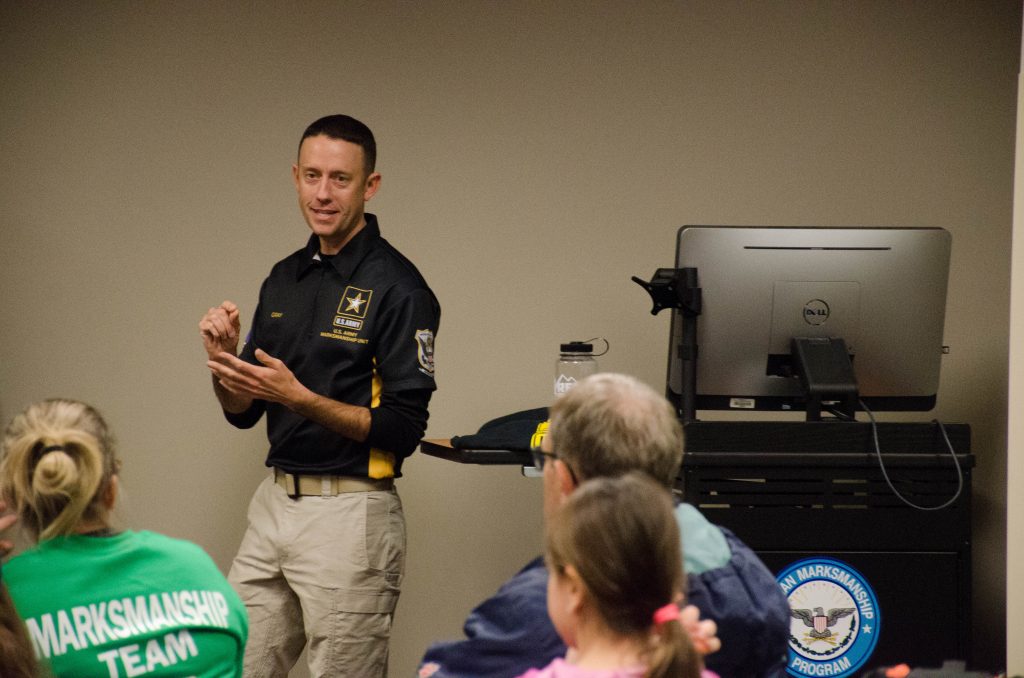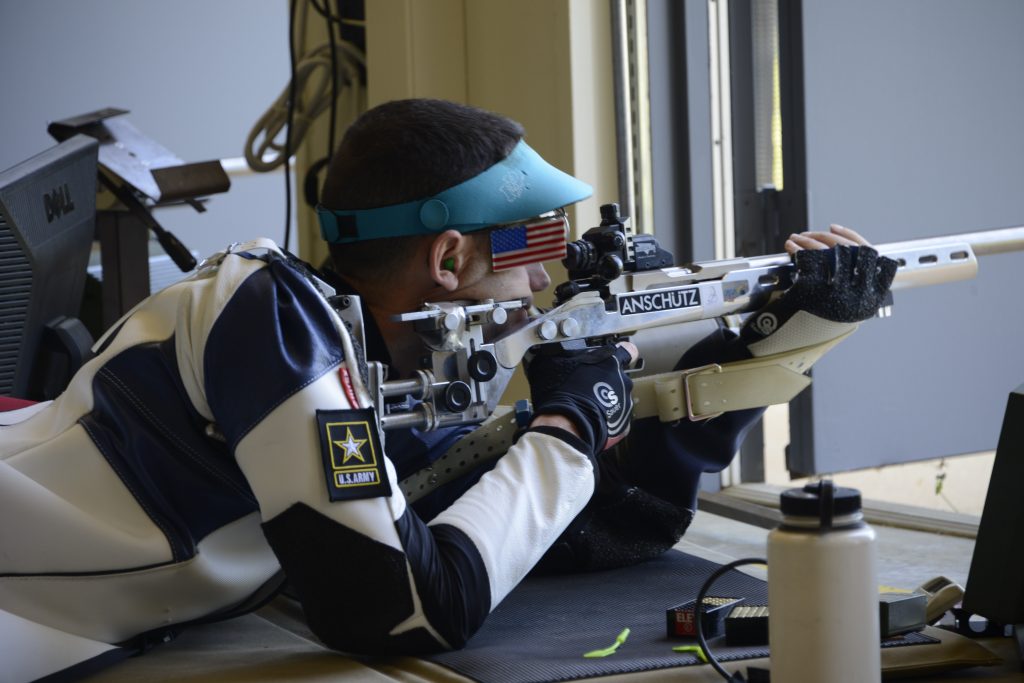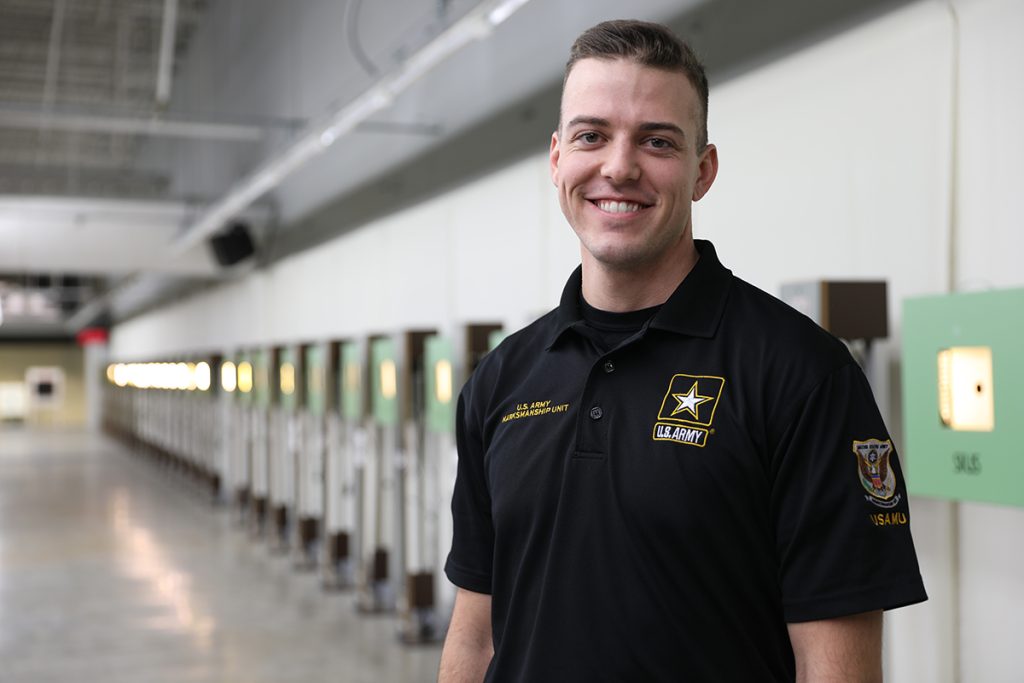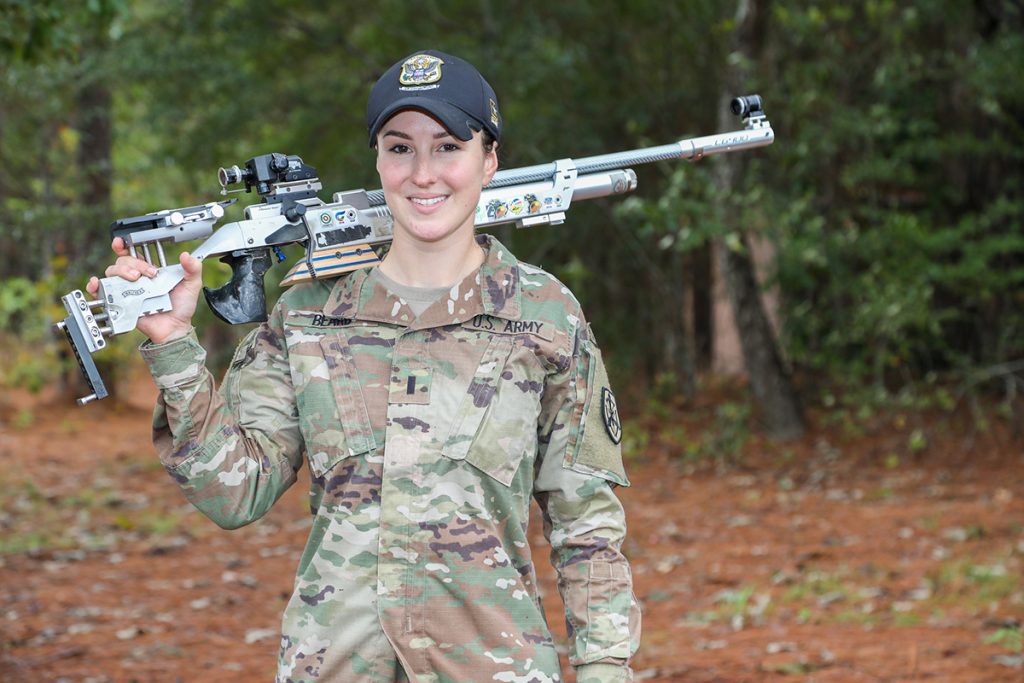Competition Nerve Control From The Experts: Smallbore
April 2, 2021
Civilian Marksmanship Program▸The First Shot▸Competition Nerve Control From The Experts: SmallboreWhen it comes to marksmanship competition, skills can only go so far – having a strong mental game is also a key part of reaching success. In an effort to gain tips on better regulating the psychological aspects of competitive shooting, the Civilian Marksmanship Program (CMP) asked respected athletes to share their personal experiences from the firing line on what they do to control their emotions when nerves creep in and the pressure is high.
SFC Hank Gray, 41, has been a decorated member of the Army Marksmanship Unit, based out of Fort Benning, Georgia, since 2003. During that time, he has competed as a running target and international rifle team athlete, accruing several awards and recognitions through the military as well as on the competition stage.

As a junior, he claimed back-to-back running target titles at the USA Junior Olympics in 1997 and 1998 and went on to become a member of the winning team at the World Championship event in 2002. He holds numerous silver and gold medals from national- and global-level events and has even been a member of the U.S. National Team.
In 2010, Gray was deployed to Afghanistan to train Afghan National Army and NATO forces in marksmanship operations. In 2010, Gray earned the National Title in the National Rifle Association Conventional Prone smallbore match and helped set the Team National Record for Prone Iron Sights at Camp Perry in 2013.
Currently, Gray stands as the team chief and head coach of the international rifle team and travels the country instructing others on marksmanship fundamentals.
“What is pressure really? For me, whenever talking about pressure and how to handle it in regards to competition, I like to have a little discussion about what it is, really. Webster defines pressure as the burden of physical or mental distress. Of course in shooting competitions, we are talking primarily about the mental side of things.
Where does it come from? We have decided that pressure is mental distress, but where it comes from might be more useful in our attempt to overcome it. There can be many sources, both external and internal, for pressure. External examples might be your parents telling you to ‘win or else,’ perhaps a coach threatening to kick you off the team or maybe a bunch of money as a prize. Internal pressure generally stems from your own desire to perform at your very best. Perhaps it is to avoid perceived embarrassment among your peers, an attempt to impress someone or the thought of how your life will change after this competition. Both external and internal pressure are linked together and frequently combine to create the overall feeling of ‘pressure’ during a competition.
What does it do? The next topic, then, is to discuss what happens when we experience pressure during a competition. Most people would probably agree that the biggest, most noticeable impacts are generally physical, like increased pulse rate and reduced steadiness. Mental impacts can occur as well, such as a change in your normal focus. All of these tend to result in a breakdown of the fundamentals, like a bigger hold and/or poor triggering. Unfortunately, the overall result is then a much lower score than expected. However, one thing we should discuss is that some of the physical changes are not all necessarily bad. Pressure can increase the amount of adrenaline in the body (where the increased pulse comes from), but it also improves your visual acuity and can enhance focus (which both help if used properly).
How to deal with it? Discussing all the previous points helps paint a better overall picture and prepare the background for actually dealing with the pressure. Most of the time, pressure comes from within your own self. While the external motivators are there, like money or maybe a nagging coach, the way you feel/think/react to those things are generally self-inflicted. It may not do a lot to reduce the pressure, but knowing that it is coming from within can be beneficial in attempting to address it. Generally speaking, whether you win or lose in shooting sports, your family will continue loving you and your life will continue to go on. Realizing the overall big picture can help reduce the gravity of the situation you are currently in when feeling pressure.
One of my favorite techniques for dealing with pressure is to remember a time in my past in which I performed well during a pressure-filled situation. For me, one of the best examples of this was during the Superfinal at the Camp Perry Open one year. I was shooting against numerous members of the USA Shooting National Team (and future Olympians). As we got down to just a few people remaining, I was still standing strong and shooting very well. My heart was pounding, thinking about winning, and I easily saw the pulse in my sights. In fact, at times it seemed to match the beat of the very loud music perfectly.
I maintained my focus on my shot process and centered my hold on the target, in spite of the movement I was seeing. Clean triggering allowed me to take shots within my hold, and most of them were very deep. I shot something like a 104.7 over my last 10 shots of the Superfinal and ended up winning overall. It was a fantastic and amazing feeling.
I draw a lot of strength from that performance and use it and others frequently during pressure situations. The biggest thing for me was the realization that in spite of my heart beating quickly and/or my hold moving more than normal, I was still able to take quality shots and achieve a high score. Remaining focused on the fundamentals and my shot process rather than getting caught up in the ‘pressure’ allowed me to perform well.
All you need is just one successful experience to use and then continually build more and more successes. While the pressure may never go away, having a tried and true technique to deal with it will become yet another item in your toolkit.
How to increase pressure in practice? This is one of the biggest challenges we face as shooters. It is nearly impossible to simulate the pressure one may feel at a competition during practice. How can you even come close to simulating the Olympic Games in practice? However, creating competitions in practice with some meaning to them helps to simulate the necessity of performing on demand.
Shooting against your fellow teammates and playing various games with them is the easiest way to do this. Of course, if you train alone, then you have to come up with some other ideas. There are a few games that can be played solo, but sometimes you might need the help of a coach or parent to come up with other ideas. Try to create some consequences for not achieving a set of goals or rewards for superior performance.
A big key for the coach helping in this manner is to find the thing that motivates or creates pressure for each athlete because it is often different for different people. A few ideas for creating this pressure are consequences like making a shooter just do dry fires or holding for the rest of the training session, cleaning the range, betting money, physical exercise, etc.
Pressure is something that each athlete experiences differently and reacts to differently. However, one can learn to deal with/still achieve high results in the face of it during competition. Drawing on past successful experiences and simulating it as much as possible in practice are the best ways to improve, along with putting yourself in those pressure situations often.
Don’t be afraid to compete with someone or attend that match somewhere. Learn to embrace the pressure and try to enjoy those situations. Many of us began this sport because we enjoyed it upon our first introduction. Try to remember those times when you begin feeling the effects of pressure and hopefully you will learn to manage the pressure better.

SGT Tim Sherry, current member of the U.S. Army Marksmanship Unit
Sherry proved his talents as co-captain of the University of Alaska Fairbanks Rifle team, where he competed as a member from 2012 to 2016. In 2014, he was the NCAA National Champion in smallbore – named the Alaska Nanooks Most Outstanding Male Athlete for the 2013-2014 school year. That same year, Sherry was the Junior Olympics Smallbore National Champion. He is a nine-time All-American and is an athlete on the U.S. National Team.

Sherry enlisted with the Army in 2017 and serves as a member of the Army Marksmanship Unit. Sherry was the 2019 USA Shooting National Champion in smallbore and won gold in smallbore at the 2019 Pan American Games (setting a new record for the event), while also placing eighth overall at the World Cup in Rio de Janeiro. Currently, he is leading the way for a spot to represent the United States in smallbore at the Tokyo Olympics.
“Like anything, I think it’s worth practicing any strategies before you actually feel nervous. If I’m practicing strategies to use under pressure, I try to make myself uncomfortable. Two easy ways to get a little uncomfortable in practice are competing head-to-head with a teammate or forcing yourself to shoot in an uncomfortably short amount of time, say 10 shots in seven minutes.”
Some of the biggest moments of pressure I’ve felt in shooting were at NCAA Championships, but I have had plenty of pressure-filled competitions throughout my career. I think it’s worth pointing out that the feeling of pressure and nerves never completely goes away. We just might ‘outgrow’ some situations that used to make us feel nervous.
My best piece of advice for handling pressure is not fighting or being afraid of it. I know this sounds a lot easier on paper than it is in practice, but hear me out.
Every time I have felt nervous in this sport, it’s because I’m on the verge doing something really important to me. In other words, I’m right where I want to be. It may not feel like it when your heart is pumping out of your chest, but this is the situation you have been working so hard for. So, why not welcome the pressure as a sign that you’re about to do something great?
Welcoming the pressure and nerves helps me think clearly and focus on what I need to. A lot of times, my heart rate will increase because of the nerves, so I focus on slowing my breath between shots. Other than that, my goal is to perform my shot process just like I have countless times in practice.”
1LT Sarah Beard, 29, of the U.S. Army Marksmanship Unit, began her shooting career back in 2006 in the basement of her home, practicing air rifle. The daughter of a marksmanship athlete with the U.S. Army as well as a 1984 Olympian, she quickly realized her natural talent for the sport and went on to compete at the state, national and global levels.

In 2009, she joined the Texas Christian University (TCU) NCAA rifle team, where she was repeatedly named first-team All-American in smallbore and air rifle and helped the team reach multiple NCAA National Championship titles.
As an individual, Beard was a gold medalist at the 2010 World Championships in the 3P Junior Women’s event and also went on to receive several other accolades, like the 2013 USA Shooting National Champion title in 3P and Prone. Upon graduation from TCU, she continued to cultivate her craft as an athlete at the Olympic Training Center in Colorado Springs.
In 2014, she earned gold at the USA Shooting National Championships in Prone and became the National Champion in Air and 3P in 2015. In 2017, she joined the Army Marksmanship Unit and travels the world competing and educating others. Her career still strong, Beard is now a five-time World Cup finalist and earned the 50m 3P Rifle Championship title at the 2019 Pan American Games.
“Dealing with Pressure
Pressure affects each person differently, so there is no single approach to perfect performance under pressure. I’ve heard many coaches insist that there is no difference between matches and practice; the distance, target size and equipment are all the same. While the requirements may all be the same, something always feels a little different when walking into a match.
Athletes begin to feel a difference before and during a big competition because their minds are busy trying to prepare them for every possible scenario. This is just the brain doing its job, but that can easily become a distraction.
Imagine you are shooting the best match of your life and preparing to shoot the last 10 shots. It would be very strange for you not to feel differently during those shots. Maybe your heart rate picks up, or your thoughts begin racing. The best way to handle that situation is to see it how it is—you are shooting well because you practiced hard to get there, and you want to do well. That’s a good thing! The only thing to do is to trust your training and execute as well as you possibly can.
Easier said than done! I don’t know a single athlete that has not lost some amount of focus during one of those moments. One thing I have found is that just because you may feel a change when you are nervous, that does not mean you should change something about how you shoot. Your goal is to always perform each shot as closely as possible to how you trained. That’s what it means to trust your training.
If you are not confident that you can do that, then the best way to prepare for a match is to practice your shot routine under every circumstance you can imagine. It’s important to remember that training for pressure is a gradual process. Start with the basics to make sure you do not lower your standards when the pressure arrives.
- Begin with developing your shot process in a way that is clear to you. Breath count, relaxing, key words, sight alignment, trigger squeeze, follow through—you must build and memorize the sequence that allows you to shoot the most 10’s.
- Next, introduce distractions. Small ones to begin with, and then “level up” from there. You can ask a coach to play random music, make noise, count down your shots or any possible distraction they imagine. If you are on your own, you can require yourself to shoot a certain amount of shots under a slightly shorter period of time than normal (find your “time limit” for a good shot), challenge a friend to shoot against (even virtually) or make yourself report your scores to someone as soon as you are finished shooting.
- Gradually build up distraction levels in training as you execute shots exactly the way you want. Making yourself uncomfortable during training may require some creativity, but it is possible. The key is to make sure that you are staying on task and performing shots how you want to without responding to distractions.
Like any other situation in a competition, it ultimately comes down to executing as many quality shots as possible. Don’t be afraid to get creative with training for pressure, but also be open to trying different techniques to help you learn which ones help you stay on track. This could be mindfulness, breathing, key words or muscle relaxation.
Just remember that every shot fired in practice is for one purpose: to shoot as many excellent shots as possible, whether you feel pressure or not.”
This, by far, is my favorite article from the CMP newsletter the last couple of years! Thank you, more like this please!
Thank you for this helpful article. I’m going to try the time reduction techniques in my standing in dry fire practice tomorrow morning. 🙂
I have learned those lessons over the past half century and wish I had been taught them when I was shooting competitively.